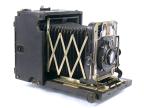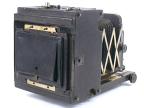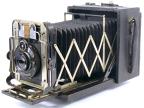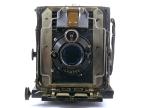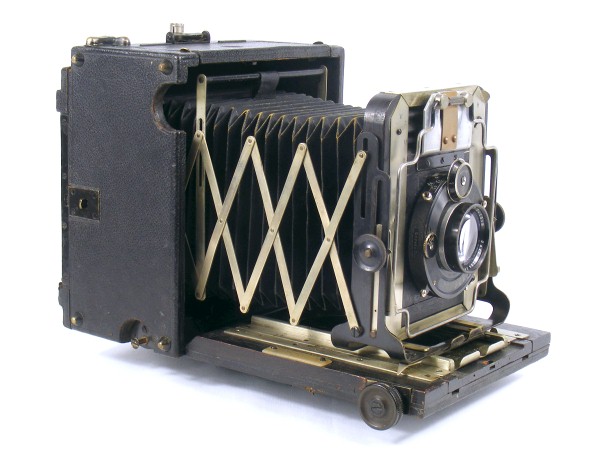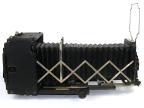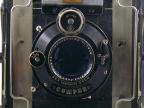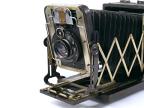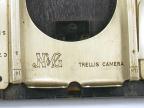Trellis Camera
Newman & Guardia
| Name: | Trellis Camera |
| Type: | Hand & Stand Camera |
| Manufacturer: | Newman & Guardia Ltd |
| Country of Origin: | United Kingdom |
| Construction: | Solidly built hand & stand camera with leather covered mahogany body, triple extension black leather bellows and expanding trellis supports for the lens standards |
| Production Period: | 1911 - 1930s |
| Plate / Film Size: | 3¼" x 4¼" plate in double dark slides |
| Lens: | Carl Zeiss Jena Tessar f4.9 F=15cm (serial 641476) |
| Shutter: | Dial-set Compur, speeds 1 - 1/200, B & T (No 934295) |
| Movements: | Rising front, tilting front |
| Dimensions (w x h x l): | 15.5 x 16.5 x 9 cm (closed) |
| Date of this Example: | c1930? |
| Serial Number: | Serial T172 stamped into central extension. |
| Availability: |
|
| Inventory Number: | 616 |
|
Photos copyright © 2014 David Purcell. Do not use without permission. |
Description
The Trellis camera by Newman & Guardia is an uncommon Hand & Stand camera that was a high end instrument advertised in 1911 as being "specially interesting to Explorers, Travellers and those requiring an efficient instrument which is capable of the extremes between Wide-Angle and Tele-Photo work". It has a drop bed, separate wide angle rack and wide angle flap on the top face, combined with triple extension bellows to support these extremes. It has a well made body of leather covered mahogany and is very solidly built.
The serial number is T172 and is one higher than the highest listed on the Early Photography web site (last accessed January 2025). This example is likely to be a late model, possibly one that was sold when it was advertised again in the 1930s, some 20 years after its initial introduction. The serial number on the Zeiss lens corresponds to a date of about 1926, but it may have sat on the shelf for a time before being sold or may even have been supplied or fitted by the owner. It appears that less than 200 of these cameras were produced, most (though apparently not all) in ¼ plate size like this one.
The camera has a removable lens panel. It is equipped with a rising and tilting front, and a rotating back.
The examples on the Early Photography website, adverts and others pictured on the web either have no viewfinder or, more usually, an N & G reflecting finder. This example has a wire frame finder. The main wire frame appears to use original N & G fittings, so may have been a factory adaptation or option when ordered.
Notes
The knob used to operate the wide angle rack is missing on this example; just the square section shaft remains.
![[ ]](../../images/unchecked.png)
![[x]](../../images/checked.png)
